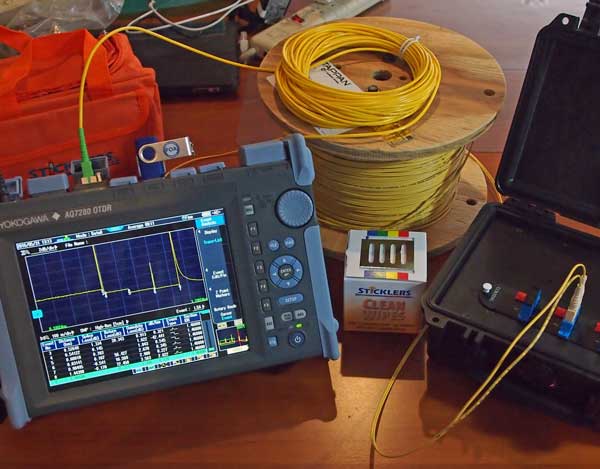The optical fibre diameter analyser provides detailed measurements for fibre optics.
Wiki Article
The Duty of Optical Fiber Testing in Ensuring Top Quality and Effectiveness in Connectivity Solutions
In today's swiftly developing digital landscape, the significance of optical fiber screening can not be overstated, as it offers as a foundation for ensuring the top quality and efficiency of connection solutions. As innovation proceeds to advancement, the future of optical fibre screening positions appealing challenges and chances that warrant closer exam.Relevance of Optical Fibre Screening
The significance of optical fibre screening can not be overemphasized in making sure the integrity and efficiency of communication networks. As the backbone of modern telecoms, optical fibres facilitate high-speed information transmission, making their integrity important to functional success. Examining acts as a positive measure to determine possible concerns such as signal loss, depletion, and physical damage, which can endanger network performance.Regular testing allows for the verification of installation top quality and the detection of problems that can affect data stability - ofda. By employing strenuous screening protocols, network operators can alleviate the threats linked with network failings, including downtime and economic losses. Moreover, optical fibre screening makes sure conformity with sector standards and laws, enhancing the overall high quality of service provided to end-users.
Eventually, the systematic analysis of optical fibers adds to the long life and performance of interaction systems. It enables stakeholders to make educated choices pertaining to maintenance, upgrades, and troubleshooting. In a landscape where data is progressively important, focusing on optical fibre testing is vital to maintaining durable and reliable connection options, thereby supporting the needs of contemporary digital environments.
Types of Optical Fiber Examinations
Numerous screening techniques are employed to make sure the functionality and reliability of optical fibres within interaction networks. These tests can be broadly categorized right into 2 major types: installment examinations and maintenance examinations.Installation examinations are conducted instantly after the installation of optical fibre wires to confirm their performance and honesty - ofda. The most common installment examinations consist of Optical Time-Domain Reflectometry (OTDR) examinations, which assess the top quality of the fiber by identifying faults or breaks, and end-to-end loss examinations, which gauge the complete optical loss from one end of the fibre to the other
Maintenance examinations, on the various other hand, are performed periodically to guarantee ongoing efficiency and identify potential concerns over time. These include aesthetic assessment, which look for physical damages or incorrect setups, and continuity examinations, which validate that the signal can travel through the fibre without disturbance.
In addition, advanced examinations such as Polarization Setting Diffusion (PMD) and Chromatic Diffusion (CD) examinations can be performed to review the fiber's efficiency under various problems. By utilizing these diverse testing methods, specialists can maintain high requirements of top quality and reliability in optical fiber networks.
Benefits of Normal Testing
Routine testing of optical fibers plays a vital role in maintaining the general performance and dependability of communication networks. By conducting regular assessments, organizations can guarantee that their fibre optic installations meet sector requirements and run effectively. This positive technique assists to identify potential weak points and destruction with time, permitting prompt treatments before issues escalate.
Cost-effectiveness is another benefit. By addressing small problems early, companies can prevent the high costs related to major repair services or system failures. Routine testing additionally fosters compliance with regulatory requirements, ensuring that the network sticks to required safety and security and performance requirements.
Typical Concerns Identified
Identifying usual concerns in optical fibre networks is necessary for keeping ideal efficiency and reliability. Various elements can add to interruptions, including physical damages, bad installment techniques, and ecological influences.Physical damages, such as bends, breaks, or abrasions, can substantially break down signal quality. Incorrect installment strategies, consisting of too much tension or insufficient securing of cables, might result in boosted attenuation and loss of connectivity. In addition, environmental factors such as temperature changes, moisture access, and rodent disturbance can jeopardize the honesty of the fiber.
Connector concerns additionally regularly arise, with inappropriate placement or contamination resulting in enhanced insertion loss. Additionally, splicing errors can present considerable signal deterioration otherwise performed with accuracy.

Resolving these usual problems through normal optical fibre testing not just enhances network integrity but additionally enhances overall efficiency, guaranteeing that connection options remain durable and efficient.
Future Fads in Evaluating
As the demand for high-speed connection continues to increase, the future of optical fibre screening will increasingly concentrate on automation and advanced analytics. The combination of artificial knowledge (AI) and device learning (ML) in testing procedures will make it possible for more effective information analysis and anticipating upkeep, minimizing downtime and ofda enhancing general network integrity. Automated testing options will certainly improve the examination and certification of fibre networks, decreasing human mistake and boosting screening throughput.One more substantial pattern is the adoption of remote testing modern technologies. As the release of fiber networks increases into remote and underserved areas, remote screening capabilities will enable specialists to check and diagnose network problems without physical presence, thereby decreasing functional expenses and enhancing feedback times.
Moreover, there will certainly be a shift in the direction of more comprehensive screening requirements that encompass not just typical loss measurements yet additionally performance metrics such as latency and bandwidth application. This alternative strategy will certainly assist in much better network monitoring and optimization approaches.
As these fads advance, the optical fibre testing landscape will certainly not only boost the high quality and performance of connection options but likewise sustain the growing intricacies of contemporary communication networks.
Verdict
In conclusion, optical fibre testing offers as a basic component in maintaining the stability and performance of interaction networks. The continuous dedication to routine testing not just improves information transmission but also straightens with market criteria, cultivating integrity in network frameworks.Report this wiki page